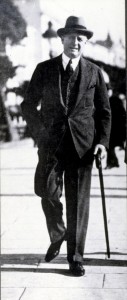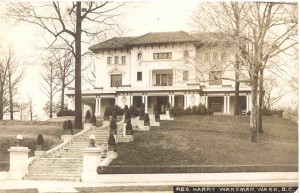Wardman Bio
 Harry Wardman (1869-1938), the son of textile workers, left his native Bradford, England alone, at the age of seventeen. Arriving in New York in 1889, he took a job as a floorwalker in a department store but left after only a few years, first to work in Wannamakers in Philadelphia, and shortly afterward as a carpenter. In 1895 he moved again, this time to Washington where job opportunities were greater and wages slightly higher than in other parts of the country. Washington, somewhat insulated from economic swings by the presence of the federal government, had recovered more quickly from the nation-wide depression of 1893.
Harry Wardman (1869-1938), the son of textile workers, left his native Bradford, England alone, at the age of seventeen. Arriving in New York in 1889, he took a job as a floorwalker in a department store but left after only a few years, first to work in Wannamakers in Philadelphia, and shortly afterward as a carpenter. In 1895 he moved again, this time to Washington where job opportunities were greater and wages slightly higher than in other parts of the country. Washington, somewhat insulated from economic swings by the presence of the federal government, had recovered more quickly from the nation-wide depression of 1893.
In Washington, Wardman went directly into the construction trade, purportedly laying floors at the new Willard Hotel. Diligent and ambitious, by 1899, he had become a builder in his own right. Three years later, at the age of only thirty, he was established as a row-house developer, a fitting occupation for a man born in a country where the row house is the dominant dwelling type.
Wardman’s early row houses were built in existing neighborhoods: Georgetown, Downtown, and Brightwood. Within a few years, he was collaborating with capital-rich individuals such as financier/developer B.F. Saul and patent attorney Harry Willson. These partnerships enabled him to purchase large tracts of land outside the old city and to construct as many as 300 houses in a single project. With these projects, Wardman introduced residential mass production to Washington on a scale not previously known. His strategies for economical construction included using land efficiently, often fitting buildings onto oddly shaped lots; ordering parts, especially ornamental trim, from catalogues; owning a lumberyard; and, in many instances, building rows of identical houses.
 Wardman bought and sold land at a frenzied pace, sometimes keeping property for only a day but always selling at a profit. According to the “Real Estate Market” report of The Washington Post, Wardman’s transactions for the week of June 11, 1905 totaled $300,000.
Wardman bought and sold land at a frenzied pace, sometimes keeping property for only a day but always selling at a profit. According to the “Real Estate Market” report of The Washington Post, Wardman’s transactions for the week of June 11, 1905 totaled $300,000.
During the First World War, Wardman’s residential construction diminished markedly but he recovered quickly after the war, building hundreds of “community houses” – that is, smaller rows, consisting of three, four, and sometimes five houses – in the 1920s in English Village, Fort Stevens Ridge, Kalorama, and Woodley Park. By 1925, Wardman claimed that his buildings housed ten percent of the city’s population. If accurate, that would have amounted to 46,000 people. That same year, The Buffalo Evening News reported,“Harry Wardman, almost alone, has solved the housing problem in Washington after carrying the capital through the period of war expansion.”
Although Wardman is best known for residential development, his oeuvre includes office buildings, banks, automobile showrooms, at least one hospital, the Capital Parking garage, and the British Embassy, which was built on land he donated to his native country. Overextended by the late 1920s, Wardman was bankrupt by the Crash of 1929. An incurable optimist, he declared, “I can quit but I don’t want to. I still have five hundred lots and I’m going to build on them.” And so he did until his death from cancer in 1938.
His unparalleled success can be attributed not only to hard work and efficient implementation of mass-production techniques, but also to uncanny real estate acumen, a high regard for quality of design and construction, considerate treatment of all his associates, and – of course – being in the right place at the right time.
